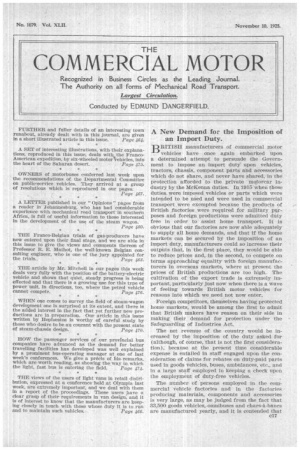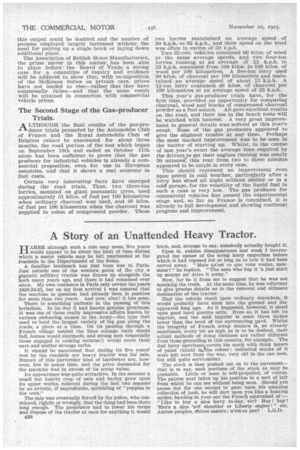A New Demand for the Imposition of an Import Duty.
Page 1

Page 2

If you've noticed an error in this article please click here to report it so we can fix it.
pt RI TI SH manufacturers of commercial motor I-1 vehicles have once again embarked upon a determined attempt to persuade the Government to impose an import duty upon vehicles, tractors, chassis, component parts and accessories which do not share, and never have shared, in the protection afforded to the private motorcar industry by the McKenna duties. In 1915 when those duties were imposed vehicles or parts which were Intended to be used and were used in commercial transport were exempted because the products of British factories were required for Military purposes and foreign productiOns were admitted duty free in order to assist home transport. It is obvious that our factories are now able adequately to supply all home demands, and that if the home markets can be secured by the imposition of an import duty, manufacturers could so increase their outputs that, in the first place, they would be able to reduce prices and, in the second, to compete on terms approaching equality with foreign manufacturers in overseas markets, where at present the prices of British productions are too high. The cultivation of the export trade is extremely important, particularly just now when there is a wave of feeling towards British motor vehicles for reasons into which we need not now enter.
Foreign competitors, themselves having protected home markets, would be among the first to admit that British makers have reason on their side in making their demand for protection under the Safeguarding of Industries Act.
The net revenue of the country would be increased by the imposition of the duty asked fOr (although, of course, that is not the first consideration), because at the present time considerable expense is entailed in staff engaged upon the consideration of claims for rebates on duty-paid parts used in goods vehicles, buses, ambulances, etc., and in a large staff employed, in keeping a check upon the employment of duty-free vehicles.
The number of persons employed in the commercial vehicle factories and in the factorieS producing materials, components and accessories is very large, as may be judged from the fact that 33,500 goods vehicles, omnibuses and chars-h-bancs are manufactured yearly, and it is contended that this output could be doubled and the number of persons employed largely increased without the need for putting up a single brick or laying down additional plant.
The Association of British Motor Manufacturers, the prime mover in this matter, has been able to place before the Board of Trade a strong case for a committee of inquiry and evidence will be adduced to show that, with re-imposition of the McKenna duties on private cars, prices have not tended to rise—rather that• they have consistently fallen--and that the same result will be attained in connection with commercial vehicle prices.
The Second Stage of the Gas-producer Trials.
ALTHOUGH the final results of the gas-producer trials promoted by the Automobile Club of France and the Royal Automobile Club of Belgium cannot be announced for about three months, the road portion of the test which began on September 18th and ended on October 11th alone has been sufficient to prove that the gas producer for industrial vehicles is already g commercial proposition, even for use in European countries, and that it shows a real economy in fuel costs.
Certain very interesting facts have emerged during the road trials. Thus, two three-ton lorries, mounted on giant• pneumatic tyres, used approximately 51 kilos. of fuel per 100 kilometres when ordinary charcoal was used, and 48 kilos. of fuel per 100 kilometres when the charcoal was Supplied in cubes of compressed powder. These two lorries maintained an average speed of 30 k.p.h. to 32 k.p.h., and their speed on the level was often in excess of 50 k.p.h.
Two 32-cwt. vehicles consumed 60 kilos. of wood at the same average speeds, an.d two four-ton lorries running at an average of 22 k.p.h. to 23 k.p.h. consumed from 108 kilos. to 109 kilos. of wood per 100 kilometres. A five-ton lorry used 90 kilos. of charcoal per 100 kilometres and maintained an average speed of about 15 k.p.h. A 2i-ton lorry consumed 48 kilos. of charcoal per 100 kilometres at an average speed of 25 k.p.h.
This year's gas-producer trials have, for the first time, provided , an opportunity for comparing charcoal, wood and blocks of compressed charcoal powder as a fuel source. All gave excellent results on the road, and• their use in the bench tests will be watched with interest. A very great improvement in general details was noticed at this year's event. None of the gas producers appeared to give the slightest trouble at any time. Perhaps the most marked improvement was to be seen in the matter of starting up. Whilst, in the course of last year's event the average time required by the drivers to get their engines running was nearly 30 minutes, this year from two to three minutes appeared to be ample in every case.
This should represent an improvement even upon petrol in cold weather, particularly after a lorry has stood all night without shelter or in a cold garage, for the volatility of the liquid fuel in such a case is very low. The gas producer for commercial vehicles has passed the experimental stage and, so far as France is concerned, it is already in full development and showing continual progress and improvement.






























